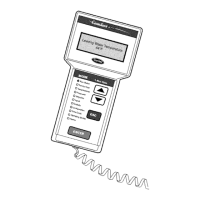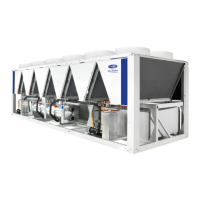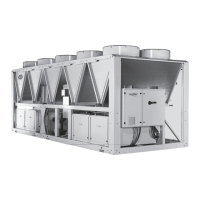5
in accordance with the national usage regulations:
• These relief valves and fuses are not safety accessories
but damage limitation accessories in case of a re,
• The high pressure switches are the safety accessories.
The relief valve must only be removed if the re risk is
fully controlled and after checking that this is allowed by
local regulations and authorities. This is the responsibility
of the operator.
When the unit is subjected to re, safety devices prevent
rupture due to over-pressure by releasing refrigerant. The
uid may then be decomposed into toxic residues when
subjected to the ame:
• Stay away from the unit
• Set up warnings and recommendations for personnel
in charge to stop the re.
• Fire extinguishers appropriate to the system and the
refrigerant type must be easily accessible.
The external relief valves must in principle be connected
to discharge pipes for units installed in a room. Refer to
the installation regulations, for example those of European
standards EN 378 and EN 13136.
They include a sizing method and examples for congura-
tion and calculation. Under certain conditions these stan-
dards permit connection of several valves to the same
discharge pipe. Note: Like all other standards these EN
standards are available from national standards organi-
sations.
These pipes must be installed in a way that ensures that
people and property are not exposed to refrigerant leaks.
These uids may be diffused in the air, but far away from
any building air intake, or they must be discharged in a
quantity that is appropriate for a suitably absorbing
environment.
It is recommended to install an indicating device to show
if part of the refrigerant has leaked from the valve. The
presence of oil at the outlet orice is a useful indicator
that refrigerant has leaked. Keep this orice clean to
ensure that any leaks are obvious.
The calibration of a valve that has leaked is generally
lower than its original calibration. The new calibration
may affect the operating range. To avoid a nuisance
tripping or leaks, replace or re-calibrate the valve.
Periodic check of the relief valves: See paragraph 1.3
“Maintenance safety considerations”.
Provide a drain in the discharge circuit, close to each
relief valve, to avoid an accumulation of condensate or
rain water.
Ensure good ventilation, as accumulation of refrigerant
in an enclosed space can displace oxygen and cause
asphyxiation or explosions.
Inhalation of high concentrations of vapour is harmful
and may cause heart irregularities, unconsciousness, or
death. Vapour is heavier than air and reduces the amount
of oxygen available for breathing. These products cause
eye and skin irritation. Decomposition products are
hazardous.
The units are intended to be stored and operate in an
environment where the ambient temperature must not be
less than the lowest allowable temperature indicated on
the nameplate. See section “11.2 - Pressure vessels”.
Carrier recommends the following drafting for a logbook
(the table below should not be considered as reference
and does not involve Carrier responsibility):
(1)
(1) Maintenance,repairs,regularverications(EN378),leakage,etc.
Engineers working on the electric or refrigeration compo-
nents must be authorized, trained and fully qualied to do so.
All refrigerant circuit repairs must be carried out by a trained
person, fully qualied to work on these units. He must have
been trained and be familiar with the equipment and the
installation. All welding operations must be carried out by
qualied specialists.
The insulation must be removed and heat generation must
be limited by using a wet cloth.
Any manipulation (opening or closing) of a shut-off
valve must be carried out by a qualied and authorised
engineer. These procedures must be carried out with the
unit shut-down.
NOTE: The unit must never be left shut down with the
liquid line valve closed, as liquid refrigerant can be trapped
between this valve and the expansion device. (This valve
is situated on the liquid line before the lter drier box.)
Equip the engineers that work on the unit as follows:
(1)
(2)
Protective gloves,
eye protection,
safety shoe,
protectiveclothing.
Fuse plug
x x x
Earprotection. x x
Filteringrespirator. x
(1) WerecommendtofollowtheinstructionsinEN378-3.
(2) PerformedinthepresenceofA1refrigerantaccordingtoEN378-1.
Never work on a unit that is still energized.
Never work on any of the electrical components, until the
general power supply to the unit has been cut using the
disconnect switch(es) in the control box(es).

